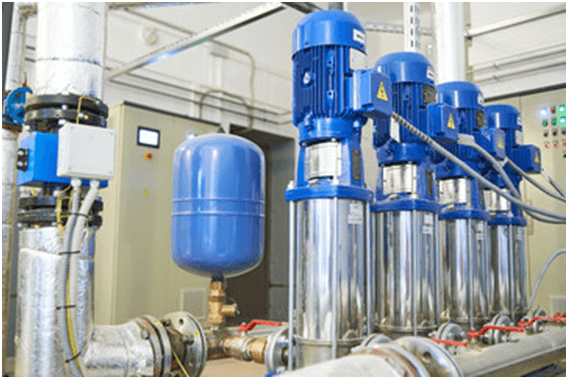A pressure pumping system used for domestic purposes is designed to ensure consistent water pressure throughout a home. These systems are particularly useful in areas with low water pressure, homes with multiple levels or properties with long water supply lines.
How a Domestic Pressure Pumping System Works
Activation:
When water is used in the home, the pressure in the system drops. The pressure switch detects this drop and activates the pump.
Water Pumping:
The pump draws water from the source (e.g. a tank) and increases the pressure.
Pressure Maintenance:
The pressurized water is stored in the pressure tank. The tank’s bladder or diaphragm maintains a consistent pressure, reducing the need for the pump to run continuously.

Distribution:
Water flows from the pressure tank to various fixtures and outlets in the home at a consistent pressure.
Deactivation:
Once the desired pressure is reached, the pressure switch turns off the pump. The pressure tank then provides water until the pressure drops again, at which point the cycle repeats.
Key Components of Pressure Pumping Systems
Function:The primary component that increases water pressure.
Types:
Centrifugal Pumps: Commonly used for boosting water pressure and are effective for continuous operation.
Function: Stores a reserve of pressurized water and helps maintain a steady water supply. The tank usually contains an air bladder or diaphragm that maintains pressure and reduces the need for the pump to run continuously.
Components:
Bladder or Diaphragm: Separates the air and water within the tank and maintains consistent pressure.
Pressure Switch: Monitors and controls the pressure within the tank, triggering the pump to turn on or off as needed.
Function: Regulates the operation of the pump based on the pressure in the system. It turns the pump on when pressure drops below a set level and off when the desired pressure is reached.
Settings:
Typically adjustable to set the cut-in and cut-out pressure levels, which control when the pump activates and deactivates.
Function: Prevents backflow of water from the pressure tank into the pump or water supply line. This ensures that water remains in the system and prevents contamination.
Location:
Installed in the pipe leading from the pump to the pressure tank or water supply.
Function: Regulates and maintains a consistent water pressure throughout the house. This is especially useful if the pressure coming from the pump is too high and needs to be adjusted to prevent damage to plumbing fixtures.
Location:
Typically installed at the point where the water supply line enters the home or at the main water line.
Function: Provides a user interface for controlling and monitoring the pump. It may include features such as digital displays, alarms and diagnostic tools.
Location:
Mounted near the pump or pressure tank.

Benefits of a Domestic Pressure Pumping System
Consistent Water Pressure:
Ensures a steady flow of water at the desired pressure, enhancing comfort and functionality.
Improved Performance:
Increases the effectiveness of showers, faucets, and appliances.
Efficient Operation:
Reduces pump cycling by maintaining a reserve of pressurized water, leading to longer pump life and lower energy consumption.
Enhanced Water Flow:
Particularly useful in multi-story homes or properties with long water lines where pressure may otherwise be inadequate.
Maintenance and Considerations
Monitor and maintain the pressure tank and pump to ensure proper operation. Check for leaks, unusual noises, or pressure fluctuations.
Adjust the pressure switch settings as needed to accommodate changes in water usage or system performance.
Keep the pump and its components clean and free of debris, and follow manufacturer recommendations for service and maintenance.